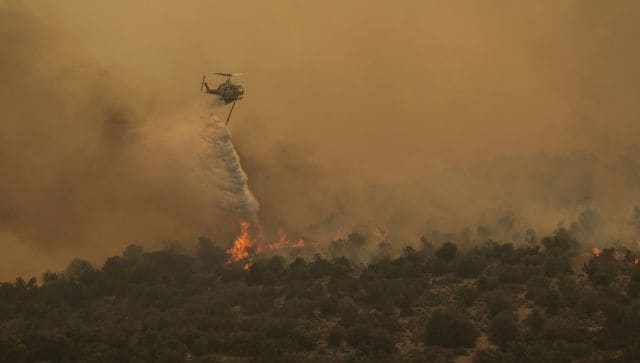Many places across Europe and the United States have been scorched by record heat, with no relief in sight in the near future. The United Nations’ World Meteorological Organization (WHO) has warned of a heightened risk of deaths as heatwaves hitting countries across the Northern Hemisphere intensified on Tuesday (18 July). Southern Europe was gripped by a second heatwave, named Charon, on Sunday (16 July). From California to Florida, several US states are reeling from extreme heat, affecting millions of people. Let’s take a look at how heatwaves are boiling parts of Europe and the US and when they can expect relief. Fiery heatwaves in Europe Nations across the Mediterranean, including tourist hotspots like Spain, Italy, Greece and Croatia, are the worst hit by the heatwaves coming from northern Africa. On 18 July, Licata city in Italy’s Sicily reported the highest temperature in Europe at 46.3 degrees Celsius. Italy has issued red alert heat advisories for 23 cities as temperatures soar.
The peak of the current heatwave is likely to hit Sicily and Sardinia islands in Italy.
As per the WMO’s forecast, heat is likely to worsen further from today (19 July) in parts of the Mediterranean, including Greece and Turkey. Two wildfires swept the coastal towns near the Greek capital Athens amid strong winds on Monday, forcing residents to evacuate their homes, reported Reuters. [caption id=“attachment_12886182” align=“alignnone” width=“640”] A firefighting helicopter releases water in Mandra west of Athens in Greece on 18 July to quell the blaze. AP[/caption] Last week, southern Europe was hit by another heatwave named
Cerberus
after a three-headed dog that guarded the underworld in Greek mythology. Forecasters have predicted the second anticyclone, Charon, could smash Europe’s highest temperature record of 48.8 degrees Celsius recorded close to Siracusa in Sicily in 2021, reported Euronews. In Spain, the mercury rose to 45.3 degrees Celsius in Figueres, Catalonia, on Tuesday. The country’s weather agency has warned that the mercury could touch 45 degrees Celsius in southeastern areas of the Iberian Peninsula. As per Euronews, the temperature of the ground in some parts of Spain has already gone above 60 degrees Celsius. Sweltering heat hits US At over 43.3 degrees Celsius, Phoenix, the capital of Arizona state, witnessed a 19th straight day of record temperature on Tuesday. The mercury surged to 47.2 degrees Celsius at 3 pm in the city, reported Associated Press (AP). “The heat is taking a major toll,” Frank LoVecchio, an emergency room doctor at Valleywise Health Medical Center in Phoenix, was quoted as saying by CNN. “The hospital has not been this busy with overflow since a few peaks in the COVID-19 pandemic.” [caption id=“attachment_12886202” align=“alignnone” width=“640”]
A firefighting helicopter releases water in Mandra west of Athens in Greece on 18 July to quell the blaze. AP[/caption] Last week, southern Europe was hit by another heatwave named
Cerberus
after a three-headed dog that guarded the underworld in Greek mythology. Forecasters have predicted the second anticyclone, Charon, could smash Europe’s highest temperature record of 48.8 degrees Celsius recorded close to Siracusa in Sicily in 2021, reported Euronews. In Spain, the mercury rose to 45.3 degrees Celsius in Figueres, Catalonia, on Tuesday. The country’s weather agency has warned that the mercury could touch 45 degrees Celsius in southeastern areas of the Iberian Peninsula. As per Euronews, the temperature of the ground in some parts of Spain has already gone above 60 degrees Celsius. Sweltering heat hits US At over 43.3 degrees Celsius, Phoenix, the capital of Arizona state, witnessed a 19th straight day of record temperature on Tuesday. The mercury surged to 47.2 degrees Celsius at 3 pm in the city, reported Associated Press (AP). “The heat is taking a major toll,” Frank LoVecchio, an emergency room doctor at Valleywise Health Medical Center in Phoenix, was quoted as saying by CNN. “The hospital has not been this busy with overflow since a few peaks in the COVID-19 pandemic.” [caption id=“attachment_12886202” align=“alignnone” width=“640”] A digital billboard showcases the temperature on 17 July in downtown Phoenix. AP[/caption] Extreme heat has also boiled El Paso, Texas, for 32 consecutive days. Several parts of Florida, including Miami city, have been affected by a persistent, record-breaking heatwave. As per WMO, a temperature sensor at Furnace Creek in California’s Death Valley National Park recorded 53.3 degrees Celsius on 16 July. Death Valley has been reporting over 43.3 degrees Celsius temperatures for 84 days, reported AP. ALSO READ:
2023 is heading to be the hottest year on record: What’s behind the intense heat?
When will this end? As per Euronews, Western European countries, including Spain and Portugal, may get some respite from record heat in the coming days. But this will not be the case for other regions. The WMO believes the hot weather in the Mediterranean region and the Balkans could continue into August. Ele Hands, the deputy chief meteorologist at United Kingdom’s Met Office, told The Independent the unrelenting heatwave across southern Europe and northern Africa is likely “persist and slowly intensify” over the coming week. The Met Office predicted temperatures around 8-12 degrees Celsius above normal will continue into August. However, the mercury may not be as high as seen in the previous weeks. According to Fox Weather, high pressure will likely advance over large parts of the Southwest and the Gulf Coast in the US for the rest of July. The high pressure traps air inside in a “heat dome”, leading to extreme temperatures, as per CNN. “Only the Southern Plains and Gulf Coast could see some relief in the coming days as the heat dome shifts back to the west and a cold front advances across the area,” according to the CNN report. Oklahoma City and Arkansas’ capital Little Rock are expected to report some relief from the hot weather on Friday, the report added. High temperatures will continue to bake Desert Southwest and Texas this week and this will probably continue till August. While scattered rainfall is likely to bring temporary relief for the Southwest, the altogether temperature pattern will continue to be hot, reported CNN. Meanwhile, the WMO has sounded the alarm and asked the world to be prepared for highly intense heatwaves. “These events will continue to grow in intensity, and the world needs to prepare for more intense heatwaves,” John Nairn, a senior extreme heat advisor at WMO, told reporters on Tuesday, as per AFP. With inputs from agencies
A digital billboard showcases the temperature on 17 July in downtown Phoenix. AP[/caption] Extreme heat has also boiled El Paso, Texas, for 32 consecutive days. Several parts of Florida, including Miami city, have been affected by a persistent, record-breaking heatwave. As per WMO, a temperature sensor at Furnace Creek in California’s Death Valley National Park recorded 53.3 degrees Celsius on 16 July. Death Valley has been reporting over 43.3 degrees Celsius temperatures for 84 days, reported AP. ALSO READ:
2023 is heading to be the hottest year on record: What’s behind the intense heat?
When will this end? As per Euronews, Western European countries, including Spain and Portugal, may get some respite from record heat in the coming days. But this will not be the case for other regions. The WMO believes the hot weather in the Mediterranean region and the Balkans could continue into August. Ele Hands, the deputy chief meteorologist at United Kingdom’s Met Office, told The Independent the unrelenting heatwave across southern Europe and northern Africa is likely “persist and slowly intensify” over the coming week. The Met Office predicted temperatures around 8-12 degrees Celsius above normal will continue into August. However, the mercury may not be as high as seen in the previous weeks. According to Fox Weather, high pressure will likely advance over large parts of the Southwest and the Gulf Coast in the US for the rest of July. The high pressure traps air inside in a “heat dome”, leading to extreme temperatures, as per CNN. “Only the Southern Plains and Gulf Coast could see some relief in the coming days as the heat dome shifts back to the west and a cold front advances across the area,” according to the CNN report. Oklahoma City and Arkansas’ capital Little Rock are expected to report some relief from the hot weather on Friday, the report added. High temperatures will continue to bake Desert Southwest and Texas this week and this will probably continue till August. While scattered rainfall is likely to bring temporary relief for the Southwest, the altogether temperature pattern will continue to be hot, reported CNN. Meanwhile, the WMO has sounded the alarm and asked the world to be prepared for highly intense heatwaves. “These events will continue to grow in intensity, and the world needs to prepare for more intense heatwaves,” John Nairn, a senior extreme heat advisor at WMO, told reporters on Tuesday, as per AFP. With inputs from agencies
)